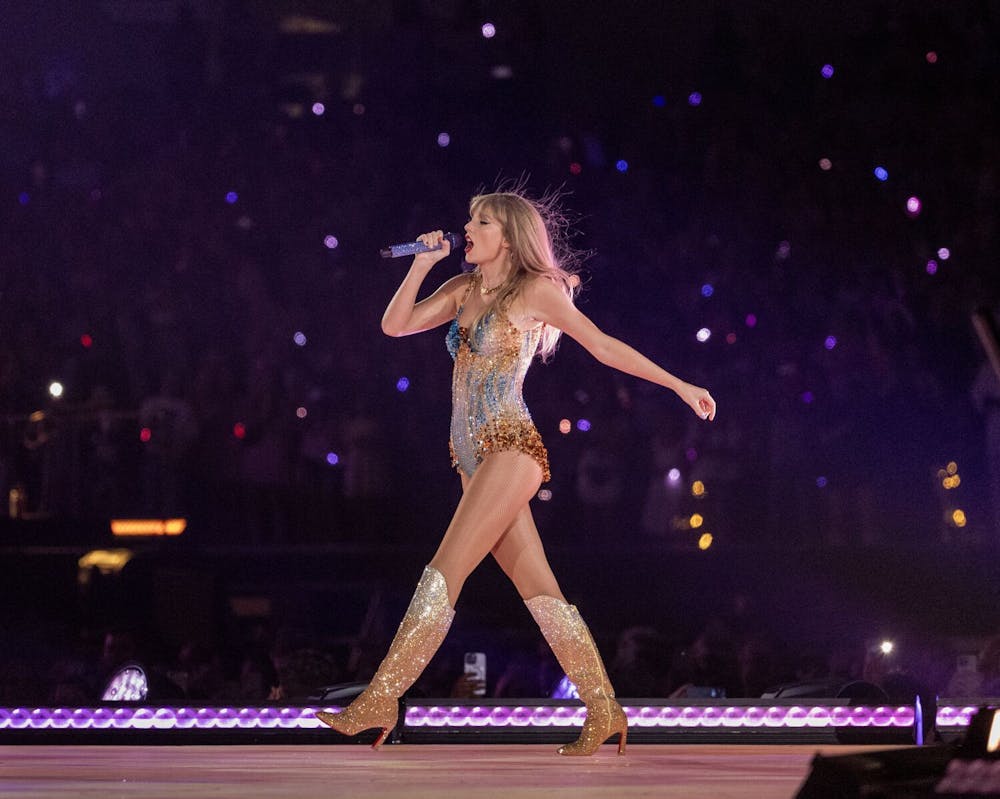I have a confession to make: I have never listened to Taylor Swift. Never searched up “Antihero” for the millionth time, never waited until midnight for her newest album to drop, never spent a frantic day on Ticketmaster praying it wouldn’t crash so I could spend way too much money at my generation's equivalent of the Super Bowl.
I was too cool for that. I was the girl who scoffed as her sister sung along, slumbered as her roommate listened to late-night releases in the dark, wondered why those kids were skipping class to spend their money on some overpriced concert ticket. However, upon watching “Taylor Swift: The Eras Tour” movie, I began to see for the first time the wonder of what being a Swiftie was like.
As anyone who has not been living under a rock can tell you, Taylor Swift’s “Eras Tour,” in which she sings selections from each of her ten albums, has been selling out stadiums across the country since last year. Swift decided to film the show at her last stop at Sofi Stadium in Los Angeles. “The Eras Tour” movie was released in theaters nationwide Oct. 13, and my friend, a devoted Swifitie, insisted we go see it.
As the camera plummeted into the stadium (literally, the view started high above Sofi and dropped straight into the packed crowd), I began to realize that my reaction to Swift was, well, not what I expected.
Director Sam Wrench’s cameras whirled me around and around, focusing on Swift at just the right moments but never letting me forget that I was just one of a larger audience. I found myself swept up with the crowd, wanting to jump and clap and pump my fist in the air at the same moments they did. By never straying from the audience perspective for too long and by repeatedly spinning the camera 360 degrees, Wrench never gave me a chance to think; instead, his film pushed me into the electrical, hysterical, fantastical energy of a million people experiencing the most climatic night of their life.
And yet not all of my feelings could be attributed to the camera work. There was a reason I found myself unable to look away from the movie screen – the eminent Taylor Swift. It occurred to me that despite my best intentions, I had heard these songs before – in the car, during games in elementary school, on my friend’s playlist – and they had lodged in my head. I had never before felt the urge to cry and dance like the spectators the camera panned in on, but now I did. She was a force of nature.
Swift's stage presence was incredible, each move calculated to perfection. It seemed as if she knew she was loved by the crowd and was relishing every second. She exuded an utter confidence and certainty in being loved.
When she first arrived on stage and greeted her fans, she had an unreadable smirk on her face as if sharing a joke only she and her fans knew about. Later, as she performed the song “22,” she gave her hat to Bianka Bryant (the late Kobe Bryant’s daughter), and hugged her, showing she cares about her fans. The last frame of the movie was Swift standing on stage, looking lovingly at her audience, and throughout the night, she would gesture to them and ask them to sing along.
As a lover of musical theatre and literature, I was also surprised by the references to the song “Cell Block Tango” from the musical “Chicago,” which the show paid homage to with the same chairs from the song, instantly recognizable to anyone who has seen the movie or musical. In “Chicago,” the women in “Cell Block Tango” pull these chairs up in one of the most famous moments of the show to lament that their lover “had it coming.” This sentiment is similar to that of vengeance in Swift’s song “Vigilante Shit,” and the background dancers even displayed Bob Fosse-esque dance moves. I was also impressed by the extreme metaphor of “Romeo and Juliet” with very specific details from Shakespeare in “Love Song,” as well as the reference to “The Scarlet Letter.”
I had only ever known Taylor Swift songs as shallow and obsessed with guys. Yet from her second song, “The Man,” a wittily written bashing of double standards which hit uncomfortably close to home, calling out my own feelings about who she was and who she was supposed to be, I began to see a different Taylor than the picture I had originally painted.
Her obvious love for her fans made me realize she had a heart – a heart that genuinely cared about her fans, not the money or applause. She wanted to love and be loved by them, and as the layers of the idea I had constructed of her from my own conceptions and other people’s words peeled away, I began to see the real Taylor – and love her, too.
Unfortunately, now that I’ve heard Taylor Swift, I find her songs impossible to get out of my head. While I (probably) wouldn’t spend hundreds of dollars on a concert ticket, there is now a large part of me that is suspiciously like a Swiftie.
CORRECTION: This story has been updated to accurately reflect the number of albums in Taylor Swift's discography.






